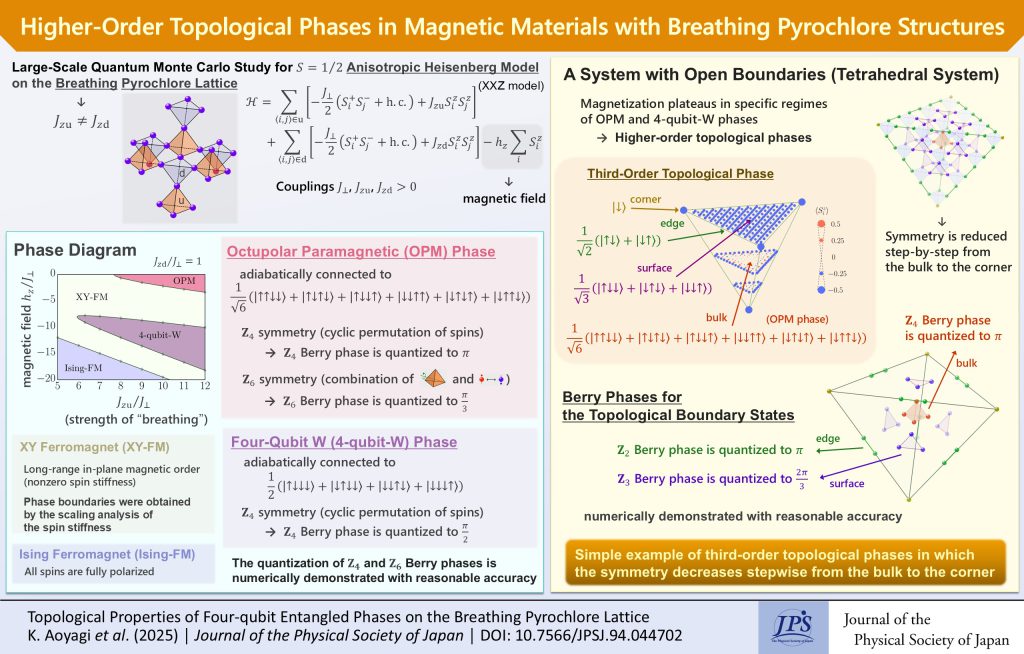Higher-Order Topological Phases in Magnetic Materials with Breathing Pyrochlore Structures
© The Physical Society of Japan
This article is on
Topological Properties of the Four-qubit Entangled Phases on the Breathing Pyrochlore Lattice
(JPSJ Editors' Choice)
J. Phys. Soc. Jpn.
94,
044702
(2025)
.
A simple example of a higher-order topological phase, in which the symmetry decreases step-by-step from the bulk to the corner, is realized in a magnetic system with a pyrochlore structure and is characterized by a series of quantized Berry phases defined for the bulk, surface, and edge.

Topology is a useful tool for understanding quantum entanglement in condensed matter physics. In particular, symmetry-protected topological phases, in which complex quantum entanglements can be classified by topological invariants, are attracting significant attention.
When materials with pyrochlore lattice structures have competing interactions, unusual quantum effects emerge. Among the various interesting states, we focus on two phases: the octupolar paramagnetic (OPM) states and the four-qubit W states. These states are characterized by four-qubit entangled states. Owing to the quantum effects, these states do not involve symmetry breaking.
In this study, we investigated the quantitative topological properties of these two phases using a large-scale numerical method called the quantum Monte Carlo method. We performed the scaling analysis of the spin stiffness to obtain the phase boundaries. We then evaluated the quantized Berry phases as topological invariants to characterize these phases, and showed that the quantized Berry phases are quantized to the values expected by the quantum entanglements in these phases.
We further investigated the topological properties of the system with boundaries. In the tetrahedral system, where the two-dimensional kagome lattice structure forms on its surface, we evaluated the local magnetic properties using a large-scale Monte Carlo method. It showed that higher-order topological phases emerge in specific regimes of the OPM and four-qubit W phases. In particular, the gapped surface and edge states of the third-order topological phase were identified within the OPM phase regime.
The Berry phases of the surface and edge states were evaluated to confirm the topological nature of the third-order topological phase. We found that the Berry phases were quantized, reflecting the symmetries and entanglement properties of the surface and edge states. It turns out that the present third-order topological phase is a simple example in which the symmetry is reduced stepwise from the bulk to the corner.
This study suggests that a large-scale numerical approach is a useful tool for analyzing higher-order topological phases in many-body systems in three dimensions.
(written by K. Aoyagi on behalf of all authors.)
Topological Properties of the Four-qubit Entangled Phases on the Breathing Pyrochlore Lattice
(JPSJ Editors' Choice)
J. Phys. Soc. Jpn.
94,
044702
(2025)
.
Share this topic
Fields
Related Articles
-
Existence of Chiral Soliton Lattices (CSLs) in Chiral Helimagnet Yb(Ni1-xCux)3Al9
Magnetic properties in condensed matter
2025-4-1
Our study examines the magnetic structure of the monoaxial chiral helimagnet Yb(Ni1-xCux)3Al9, providing first direct evidence of the formation of chiral soliton lattice state.
-
Exploring the Vibrant Interplay of Machine Learning and Physics
Cross-disciplinary physics and related areas of science and technology
Electron states in condensed matter
Elementary particles, fields, and strings
Mathematical methods, classical and quantum physics, relativity, gravitation, numerical simulation, computational modeling
Statistical physics and thermodynamics
Superconductivity
2025-3-13
This Journal of the Physical Society of Japan Special Topics edition explores how physics and machine learning complement each other and can solve unresolved problems in physics.
-
Understanding Pressure-Induced Superconductivity in CrAs and MnP
Magnetic properties in condensed matter
2025-3-10
This study reviews existing research on the pressure-induced variation of magnetic properties of transition metal mono-pnictides like CrAS, MnP, and others, aiming to understand the unconventional superconductivity observed in CrAs and MnP.
-
Traffic Signal Optimization using Quantum Annealing
Mathematical methods, classical and quantum physics, relativity, gravitation, numerical simulation, computational modeling
2025-2-25
This paper introduces a QUBO model for traffic signal optimization on real-world maps. Using D-Wave quantum annealing and SUMO simulations, the model reduces vehicle waiting times, but underperforms classical solvers.
-
Symmetry and AI: Building the Future of Physics Simulations
Magnetic properties in condensed matter
Measurement, instrumentation, and techniques
2025-2-18
Generative artificial intelligence (AI) has gained considerable attention in scientific fields. By embedding physical symmetry into AI before training, we created a faster and lighter model. Scaling improves the accuracy and unlocks the potential of physics research and applications.




